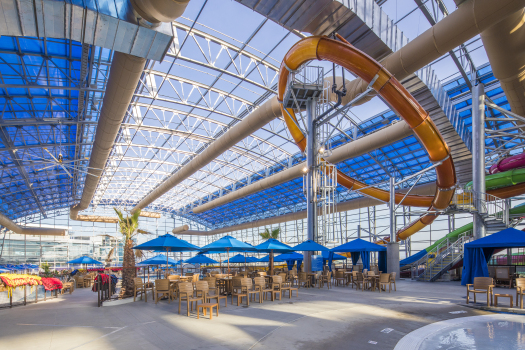As H&LA keeps abreast the continually changing impact of COVID-19 on the economy in general and hospitality sector in particular, we are sharing insights from industry experts and stakeholders with out clients and partners. H&LA’s David Sangree weighed in with the Cleveland.com on some of the signs of recovery for the downtown Hilton Hotel in Cleveland.
Published by: Susan Glaser/Cleveland.com
Published date: May 2020
The general manager of the region’s largest hotel says she is seeing signs of life in Cleveland’s tourism economy: More rooms are being booked, furloughed employees are returning to work, more people are downtown.
“Demand will come back in different waves,” said Teri Agosta, who oversees operations at the Hilton Cleveland Downtown, the publicly-owned, 32-story hotel attached to the city’s convention center.
Essential travelers are the majority of overnight guests now, but Agosta expects a modest uptick in leisure tourists in the coming weeks, as the weather improves and attractions in the city start to reopen.
“There is pent up demand,” said Agosta, noting that suburbanites are already booking rooms because they need a change of scenery. “We are seeing more people come downtown.”
Restaurants are set to reopen this weekend (for outdoor dining); the Rock and Roll Hall of Fame is tentatively planning to reopen in mid-June, and the Cleveland Indians might be playing baseball in early July (albeit, in an empty stadium).
Agosta anticipates that Northeast Ohio’s tourism industry may recover faster than some cities that have been harder hit by the coronavirus pandemic, including New York, New Orleans and Chicago. The city, within an easy drive of millions of Americans, also may be in a position to benefit, economically, as travelers choose to stay closer to home.
“We think Cleveland will rebound quicker than most cities,” said Agosta.
Agosta has been general manager of the Hilton since it opened in June 2016, a month before the Republican National Convention. With 600 rooms, the Hilton is the largest hotel in Northeast Ohio, and one of the largest in the state.
The $272-million hotel was financed by Cuyahoga County taxpayers, via a sales tax increase that also funded the adjacent Huntington Convention Center of Cleveland. At the time, county leaders argued that a large convention-oriented hotel was necessary to attract major events and groups to the city.
For now, the convention center sits empty, as public gatherings of more than 10 people remain prohibited in Ohio. Even as Ohio Gov. Mike DeWine reopens much of the state, it’s unclear when the ban on group meetings will be lifted.
A spokesman for the convention center said the next event scheduled for the facility is Aug. 10.
David Sangree, president of Cleveland consulting firm Hotel and Leisure Advisors, said the Hilton will have a hard time filling rooms without action in the convention center. “No one has been able to make a definitive statement on when conventions can resume,” he said. “There is tremendous uncertainty.”
Tourism experts generally expect that leisure travel will come back first, with a focus on regional destinations, followed by corporate transient travel. Group travel is likely to be the last segment to recover.
Several downtown hotels that focus on group travel remain closed because of a pandemic-related drop in demand, including the 484-room Westin Cleveland Downtown and the 400-room Cleveland Marriott Downtown at Key Tower. According to a reservation agent, the Westin is scheduled to reopen in early June and the Marriott in early July.
Hotel occupancy in the Cleveland area, and around the nation, remains at historic lows, although it is inching up slowly. Occupancy in the Greater Cleveland region was 24.4% for the week ending May 9, up from a low of 17% in early April, according to travel data firm STR. Nationwide, hotel occupancy rose to 30.1% for the week ending May 9, up from a low of 21% in early April.
Agosta declined to reveal the Hilton’s occupancy rate, though she said it was trending up. She said the hotel considered closing earlier this spring, but decided against it, noting that there are costs to shutting down and ramping back up. “For us, it didn’t make sense,” she said.
Most of the hotel staff was furloughed, she said, and remains out of work, although some employees have been called back.
The Burnham, the hotel’s main restaurant, has remained open for takeout, as has the Noshery. Bar 32, on the hotel’s 32nd floor, should reopen next month, according to Agosta.
The hotel continues to attract essential workers, including airline employees, medical workers and others. And as leisure travel picks up, she believes the hotel will attract an increasing percentage of that market.
“Summer in Cleveland is peak leisure time,” agreed Sangree. “And they are one of the nicest hotels in the city. Hopefully they can encourage people to travel as things start to open up.”
Julia Austin, the Hilton’s director of sales and marketing, said hotel sales staff is still working to land future business, coordinating efforts with Destination Cleveland, the convention center and other downtown hotels to rebook canceled events and meetings. “A lot of these conventions that we were supposed to have — some were booked three or four years ago,” she said. “It’s a big city effort to land that business. We don’t want to lose it altogether.”
The hotel also is pitching the venue to local brides and grooms who had to postpone weddings, and who may not be able to quickly rebook at their first-choice venue.
“It’s going to be a slow process, but I think we’ll see things pick up,” said Agosta. “We realize that this is going to go on longer than we had hoped. But there is light at the end of the tunnel.”


